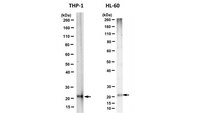Site-specific inhibitors of NADPH oxidase activity and structural probes of flavocytochrome b: characterization of six monoclonal antibodies to the p22phox subunit.
Taylor, RM; Burritt, JB; Baniulis, D; Foubert, TR; Lord, CI; Dinauer, MC; Parkos, CA; Jesaitis, AJ
J Immunol
173
7349-57
2004
显示摘要
The integral membrane protein flavocytochrome b (Cyt b) is the catalytic core of the human phagocyte NADPH oxidase, an enzyme complex that initiates a cascade of reactive oxygen species important in the elimination of infectious agents. This study reports the generation and characterization of six mAbs (NS1, NS2, NS5, CS6, CS8, and CS9) that recognize the p22(phox) subunit of the Cyt b heterodimer. Each of the mAbs specifically detected p22(phox) by Western blot analysis but did not react with intact neutrophils in FACS studies. Phage display mapping identified core epitope regions recognized by mAbs NS2, NS5, CS6, CS8, and CS9. Fluorescence resonance energy transfer experiments indicated that mAbs CS6 and CS8 efficiently compete with Cascade Blue-labeled mAb 44.1 (a previously characterized, p22(phox)-specific mAb) for binding to Cyt b, supporting phage display results suggesting that all three Abs recognize a common region of p22(phox). Energy transfer experiments also suggested the spatial proximity of the mAb CS9 and mAb NS1 binding sites to the mAb 44.1 epitope, while indicating a more distant proximity between the mAb NS5 and mAb 44.1 epitopes. Cell-free oxidase assays demonstrated the ability of mAb CS9 to markedly inhibit superoxide production in a concentration-dependent manner, with more moderate levels of inhibition observed for mAbs NS1, NS5, CS6, and CS8. A combination of computational predictions, available experimental data, and results obtained with the mAbs reported in this study was used to generate a novel topology model of p22(phox). | 15585859
 |














